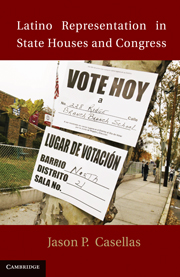Book contents
- Frontmatter
- Contents
- List of Tables
- List of Figures
- Acknowledgments
- Introduction
- 1 Latinos in Legislatures
- 2 The Effects of Population, Turnover, and Term Limits on Latino Representation
- 3 District Composition and the Election of Latino Candidates
- 4 Electing Latinos in Non-Latino Majority Districts
- 5 Voices from Within
- 6 Roll Call Voting Behavior of Latino Legislators
- 7 Conclusion
- Appendix A
- Appendix B
- Appendix C
- Appendix D
- Appendix E
- References
- Index
2 - The Effects of Population, Turnover, and Term Limits on Latino Representation
Published online by Cambridge University Press: 10 January 2011
- Frontmatter
- Contents
- List of Tables
- List of Figures
- Acknowledgments
- Introduction
- 1 Latinos in Legislatures
- 2 The Effects of Population, Turnover, and Term Limits on Latino Representation
- 3 District Composition and the Election of Latino Candidates
- 4 Electing Latinos in Non-Latino Majority Districts
- 5 Voices from Within
- 6 Roll Call Voting Behavior of Latino Legislators
- 7 Conclusion
- Appendix A
- Appendix B
- Appendix C
- Appendix D
- Appendix E
- References
- Index
Summary
To what extent has the growing Latino population translated into more Latino legislators in Congress and state legislatures? Are Latinos as likely to serve in upper chambers as lower chambers? Are Latino candidates advantaged when turnover is high within legislatures? Does the imposition of term limits further advantage Latino candidates? Are states that are more liberal more likely than conservative states to elect Latino candidates? This chapter examines Latino representation in all fifty states by tracking the growth of Latinos serving in legislatures over the past decade and comparing the percentage of Latino citizens in the population with the percentage of Latinos in each legislature. At the state level, the Latino representation in the legislature is largely reflective of the percentage of Latinos in the population. Additionally, some states have much higher turnover rates in their legislatures, thus opening up more seats for talented Latinos to win. Similarly, Latinos may have better chances of being elected in states that have enacted term limits, which eliminates the incumbency advantage. Using the latest data on turnover and term limits, I help explain the impact of these variables on Latino representation in legislatures (Moncrief, Niemi, and Powell 2004). Chapter 3 explores the conditions under which Latinos are elected to seven of the nine state legislatures with the largest Latino memberships, and will provide precise estimates of district-level effects.
- Type
- Chapter
- Information
- Latino Representation in State Houses and Congress , pp. 33 - 50Publisher: Cambridge University PressPrint publication year: 2010



